Characteristics Analysis of the Multi-Channel Ground-Based Microwave Radiometer Observations during Various Weather Conditions
Abstract
1. Introduction
2. Data and Methods
2.1. Data Description
2.2. Data Pre-Processing
2.3. Methods of Statistical Analysis
3. Brightness Temperature Characteristics Analysis during Various Weather Conditions
3.1. Characteristics Analysis of All-Sky Brightness Temperature Data
3.2. Characteristics Analysis of Clear-Sky Brightness Temperature Data
3.3. Characteristics Analysis No-Precipitating Cloudy Brightness Temperature Data
4. Effect of Cloud Liquid Water on Brightness Temperature Simulation
5. Accuracy of Temperature Retrieval Profiles and Performance of Temperature Inversion Retrieval
5.1. Accuracy of Temperature Retrieval Profiles
5.2. Performance of the Temperature Inversion Retrieval
6. Conclusions
Author Contributions
Funding
Institutional Review Board Statement
Informed Consent Statement
Data Availability Statement
Acknowledgments
Conflicts of Interest
References
- Wulfmeyer, V.; Hardesty, R.M.; Turner, D.D.; Behrendt, A.; Cadeddu, M.P.; Di Girolamo, P.; Schlüssel, P.; Van Baelen, J.; Zus, F. A Review of the Remote Sensing of Lower Tropospheric Thermodynamic Profiles and Its Indispensable Role for the Understanding and the Simulation of Water and Energy Cycles. Rev. Geophys. 2015, 53, 819–895. [Google Scholar] [CrossRef]
- Cimini, D.; Haeffelin, M.; Kotthaus, S.; Löhnert, U.; Martinet, P.; O’Connor, E.; Walden, C.; Coen, M.C.; Preissler, J. Towards the Profiling of the Atmospheric Boundary Layer at European Scale—Introducing the COST Action PROBE. Bull. Atmos. Sci. Technol. 2020, 1, 23–42. [Google Scholar] [CrossRef]
- Illingworth, A.J.; Cimini, D.; Gaffard, C.; Haeffelin, M.; Lehmann, V.; Löhnert, U.; O’Connor, E.J.; Ruffieux, D. Exploiting Existing Ground-Based Remote Sensing Networks to Improve High-Resolution Weather Forecasts. Bull. Am. Meteorol. Soc. 2015, 96, 2107–2125. [Google Scholar] [CrossRef]
- Lei, L.; Lu, J.; Zhu, L.; Wu, H. Atmospheric Remote Sensing Using Multi-Channel Ground-Based Microwave Radiometer. J. Remote Sens. 2014, 18, 180–191. (In Chinese) [Google Scholar] [CrossRef]
- De Angelis, F.; Cimini, D.; Löhnert, U.; Caumont, O.; Haefele, A.; Pospichal, B.; Martinet, P.; Navas-Guzmán, F.; Klein-Baltink, H.; Dupont, J.C.; et al. Long-Term Observations Minus Background Monitoring of Ground-Based Brightness Temperatures from a Microwave Radiometer Network. Atmos. Meas. Tech. 2017, 10, 3947–3961. [Google Scholar] [CrossRef]
- Liu, H. The Temperature Profile Comparison between the Ground-Based Microwave Radiometer and the Other Instrument for the Recent Three Years. Acta Meteorol. Sin. 2011, 69, 719–728. (In Chinese) [Google Scholar] [CrossRef]
- Ahn, M.H.; Won, H.Y.; Han, D.; Kim, Y.H.; Ha, J.C. Characterization of Downwelling Radiance Measured from a Ground-Based Microwave Radiometer Using Numerical Weather Prediction Model Data. Atmos. Meas. Tech. 2016, 9, 281–293. [Google Scholar] [CrossRef]
- Clough, S.A.; Shephard, M.W.; Mlawer, E.J.; Delamere, J.S.; Iacono, M.J.; Cady-Pereira, K.; Boukabara, S.; Brown, P.D. Atmospheric Radiative Transfer Modeling: A Summary of the AER Codes. J. Quant. Spectrosc. Radiat. Transf. 2005, 91, 233–244. [Google Scholar] [CrossRef]
- Hewison, T.J.; Gaffard, C. 1D-VAR Retrieval of Temperature and Humidity Profiles from Ground-Based Microwave Radiometers. In Proceedings of the 2006 IEEE MicroRad, 9th Specialist Meeting on Microwave Radiometry and Remote Sensing Applications, MicroRad’06, San Juan, PR, USA, 28 February–3 March 2006; IEEE: Piscataway, NJ, USA, 2006; pp. 235–240. [Google Scholar] [CrossRef]
- Güldner, J.; Spänkuch, D. Remote Sensing of the Thermodynamic State of the Atmospheric Boundary Layer by Ground-Based Microwave Radiometry. J. Atmos. Ocean. Technol. 2001, 18, 925–933. [Google Scholar] [CrossRef]
- Solheim, F.; Godwin, J.R.; Westwater, E.R.; Han, Y.; Keihm, S.J.; Marsh, K.; Ware, R. Radiometric Profiling of Temperature, Water Vapor and Cloud Liquid Water Using Various Inversion Methods. Radio Sci. 1998, 33, 393–404. [Google Scholar] [CrossRef]
- Li, Q.; Wei, M.; Wang, Z.; Chu, Y. Evaluation and Improvement of the Quality of Ground-Based Microwave Radiometer Clear-Sky Data. Atmosphere 2021, 12, 435. [Google Scholar] [CrossRef]
- Li, Q.; Wei, M.; Wang, Z.; Jiang, S.; Chu, Y. Improving the Retrieval of Cloudy Atmospheric Profiles from Brightness Temperatures Observed with a Ground-Based Microwave Radiometer. Atmosphere 2021, 12, 648. [Google Scholar] [CrossRef]
- Tan, H.; Mao, J.; Chen, H.; Chan, P.W.; Wu, D.; Li, F.; Deng, T. A Study of a Retrieval Method for Temperature and Humidity Profiles from Microwave Radiometer Observations Based on Principal Component Analysis and Stepwise Regression. J. Atmos. Ocean. Technol. 2011, 28, 378–389. [Google Scholar] [CrossRef]
- Chan, P.W. Performance and Application of a Multi-Wavelength, Ground-Based Microwave Radiometer in Intense Convective Weather. Meteorol. Z. 2009, 18, 253–265. [Google Scholar] [CrossRef]
- Xu, G.; Xi, B.; Zhang, W.; Cui, C.; Dong, X.; Liu, Y.; Yan, G. Comparison of Atmospheric Profiles between Microwave Radiometer Retrievals and Radiosonde Soundings. J. Geophys. Res. Atmos. 2015, 120, 10313–10323. [Google Scholar] [CrossRef]
- Bedoya-Velásquez, A.E.; Navas-Guzmán, F.; de Arruda Moreira, G.; Román, R.; Cazorla, A.; Ortiz-Amezcua, P.; Benavent-Oltra, J.A.; Alados-Arboledas, L.; Olmo-Reyes, F.J.; Foyo-Moreno, I.; et al. Seasonal Analysis of the Atmosphere during Five Years by Using Microwave Radiometry over a Mid-Latitude Site. Atmos. Res. 2019, 218, 78–89. [Google Scholar] [CrossRef]
- Ware, R.; Carpenter, R.; Güldner, J.; Liljegren, J.; Nehrkorn, T.; Solheim, F.; Vandenberghe, F. A Multichannel Radiometric Profiler of Temperature, Humidity, and Cloud Liquid. Radio Sci. 2003, 38, 8079. [Google Scholar] [CrossRef]
- Caumont, O.; Cimini, D.; Löhnert, U.; Alados-Arboledas, L.; Bleisch, R.; Buffa, F.; Ferrario, M.E.; Haefele, A.; Huet, T.; Madonna, F.; et al. Assimilation of Humidity and Temperature Observations Retrieved from Ground-Based Microwave Radiometers into a Convective-Scale NWP Model. Q. J. R. Meteorol. Soc. 2016, 142, 2692–2704. [Google Scholar] [CrossRef]
- He, W.; Chen, H.; Li, J. Influence of Assimilating Ground-Based Microwave Radiometer Data into the WRF Model on Precipitation. Atmos. Ocean. Sci. Lett. 2020, 13, 107–112. [Google Scholar] [CrossRef]
- Qi, Y.; Fan, S.; Mao, J.; Li, B.; Guo, C.; Zhang, S. Impact of Assimilating Ground-Based Microwave Radiometer Data on the Precipitation Bifurcation Forecast: A Case Study in Beijing. Atmosphere 2021, 12, 551. [Google Scholar] [CrossRef]
- Qi, Y.; Fan, S.; Li, B.; Mao, J.; Lin, D. Assimilation of Ground-Based Microwave Radiometer on Heavy Rainfall Forecast in Beijing. Atmosphere 2022, 13, 74. [Google Scholar] [CrossRef]
- Temimi, M.; Fonseca, R.M.; Nelli, N.R.; Valappil, V.K.; Weston, M.J.; Thota, M.S.; Wehbe, Y.; Yousef, L. On the Analysis of Ground-Based Microwave Radiometer Data during Fog Conditions. Atmos. Res. 2020, 231, 104652. [Google Scholar] [CrossRef]
- Turner, D.D.; Kneifel, S.; Cadeddu, M.P. An Improved Liquid Water Absorption Model at Microwave Frequencies for Supercooled Liquid Water Clouds. J. Atmos. Ocean. Technol. 2016, 33, 33–44. [Google Scholar] [CrossRef]
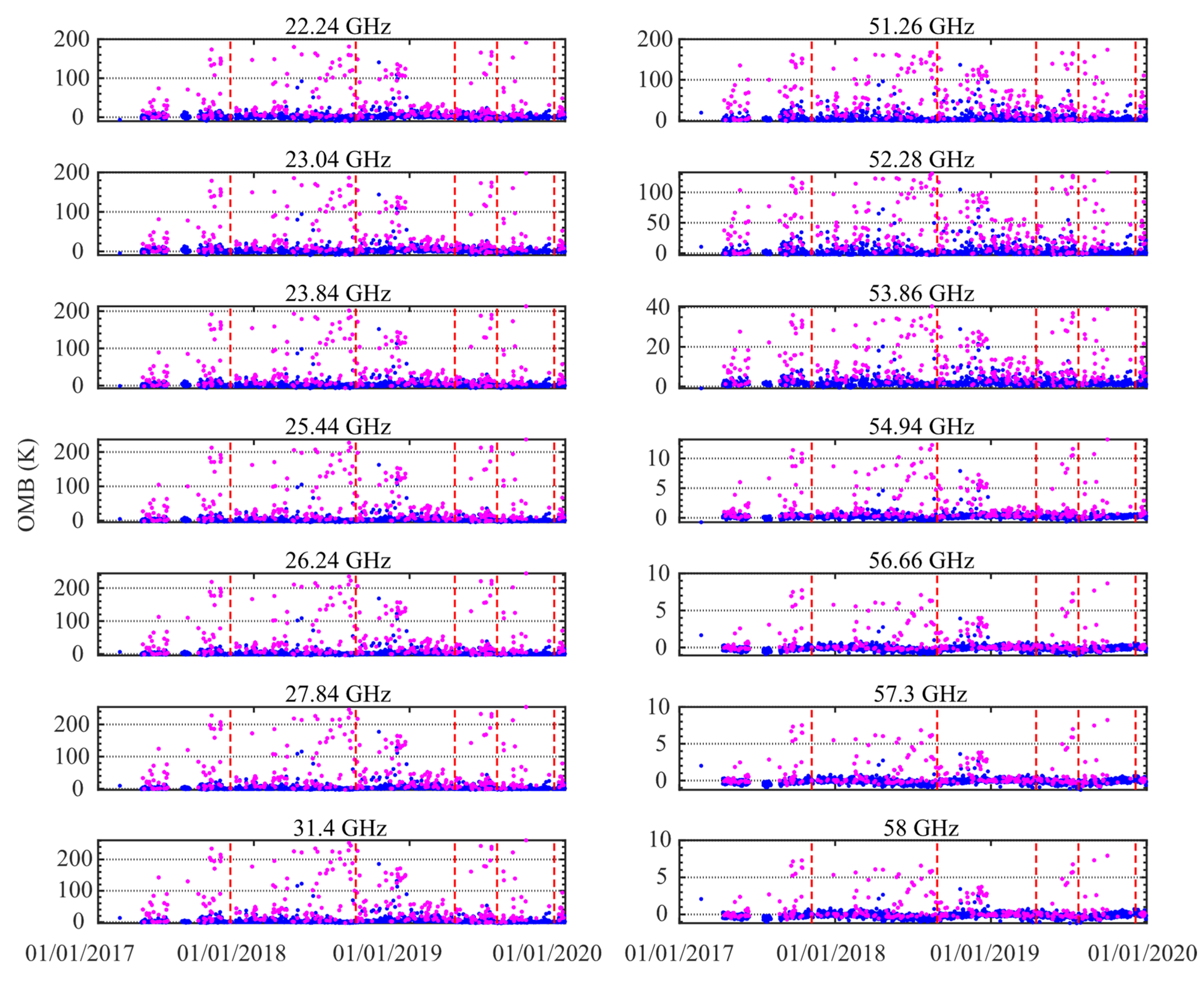
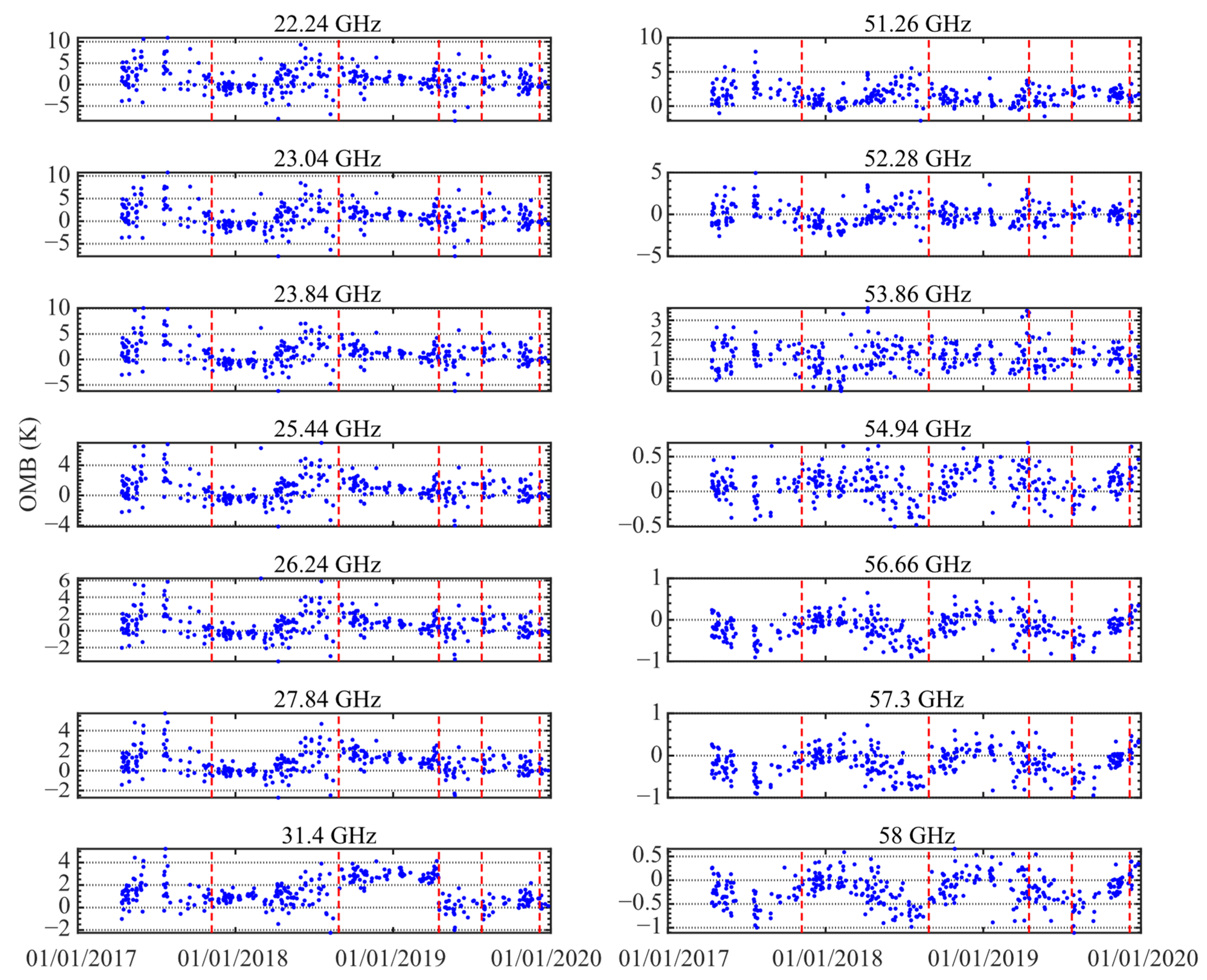


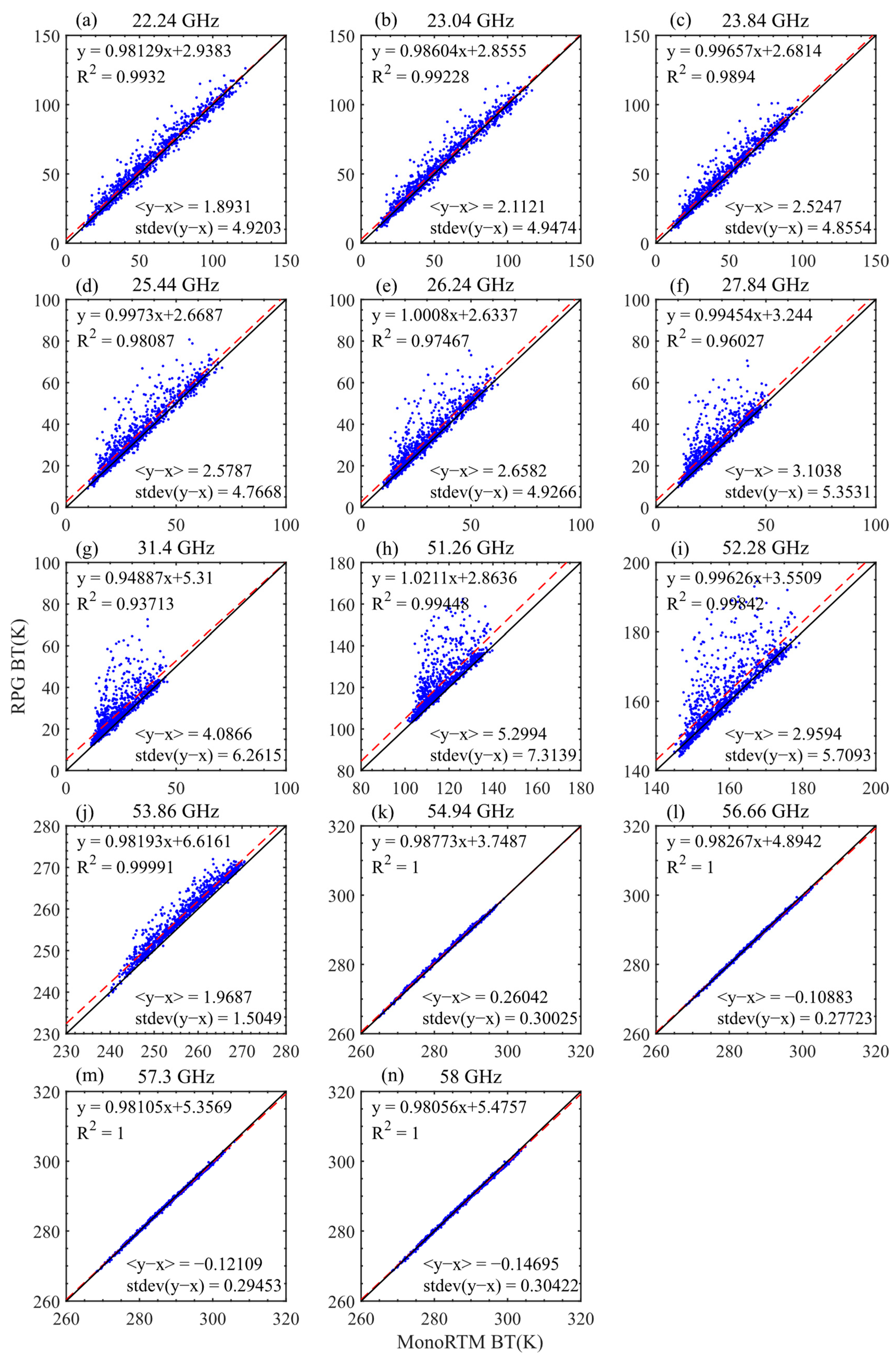

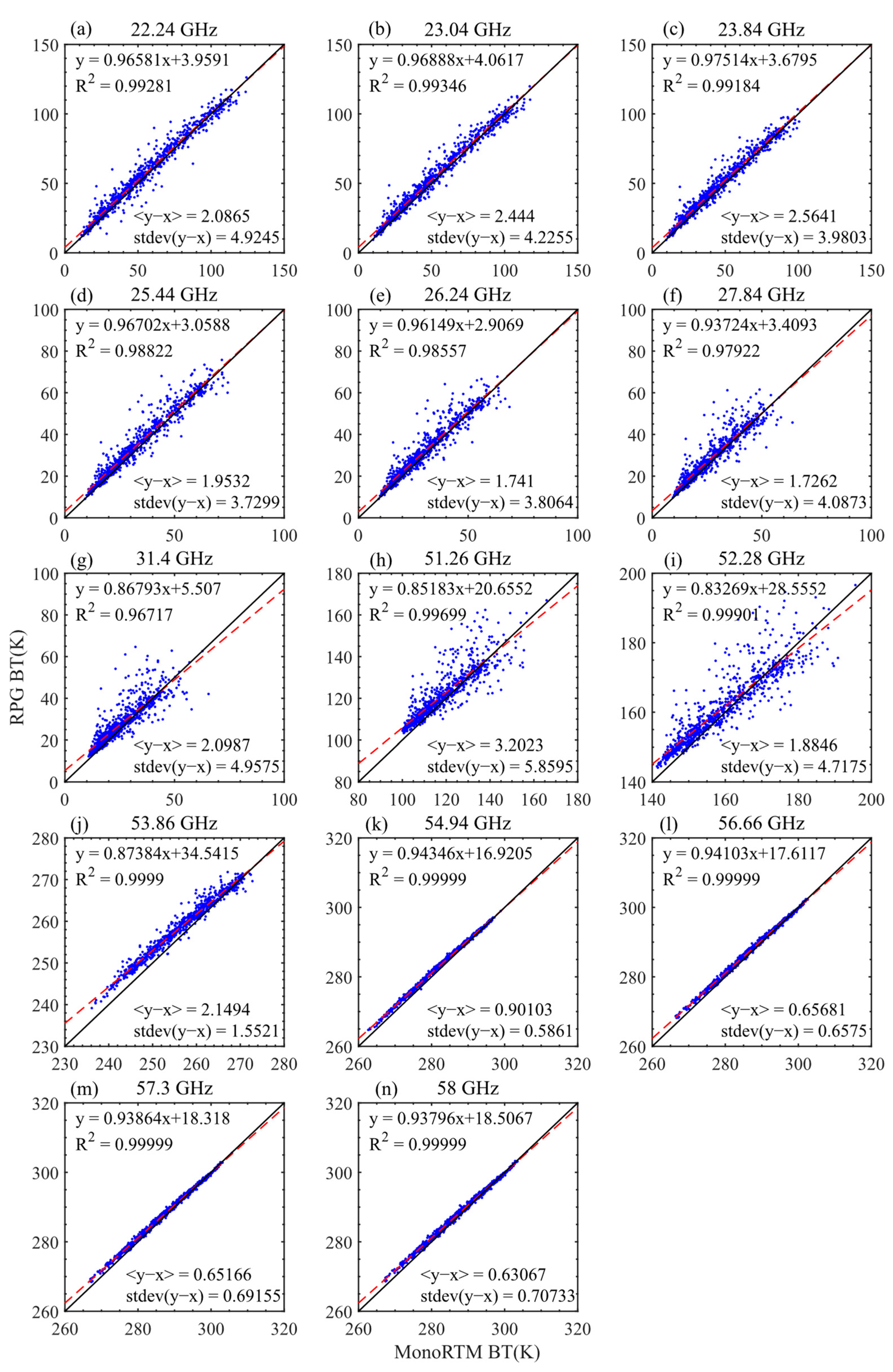
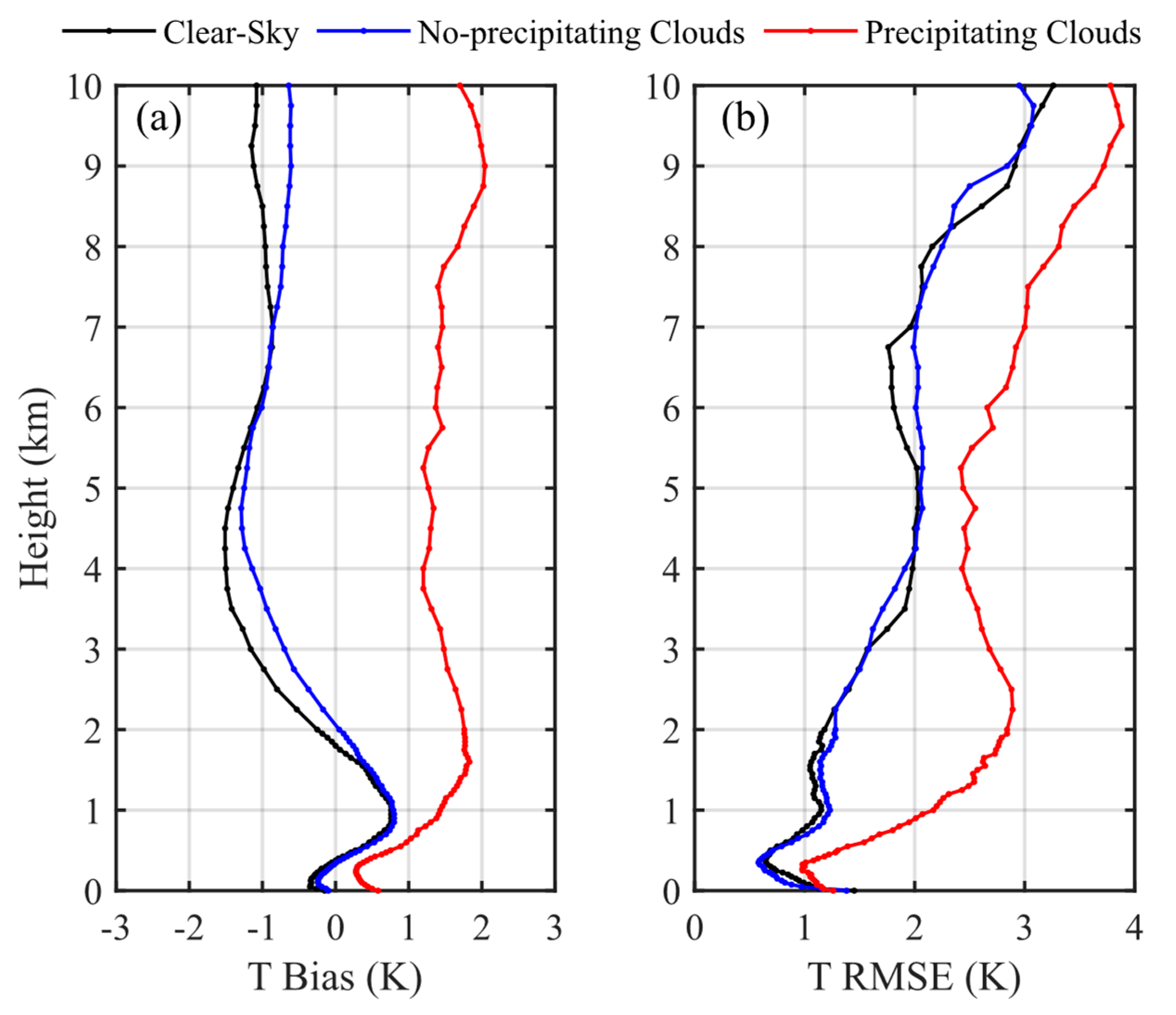
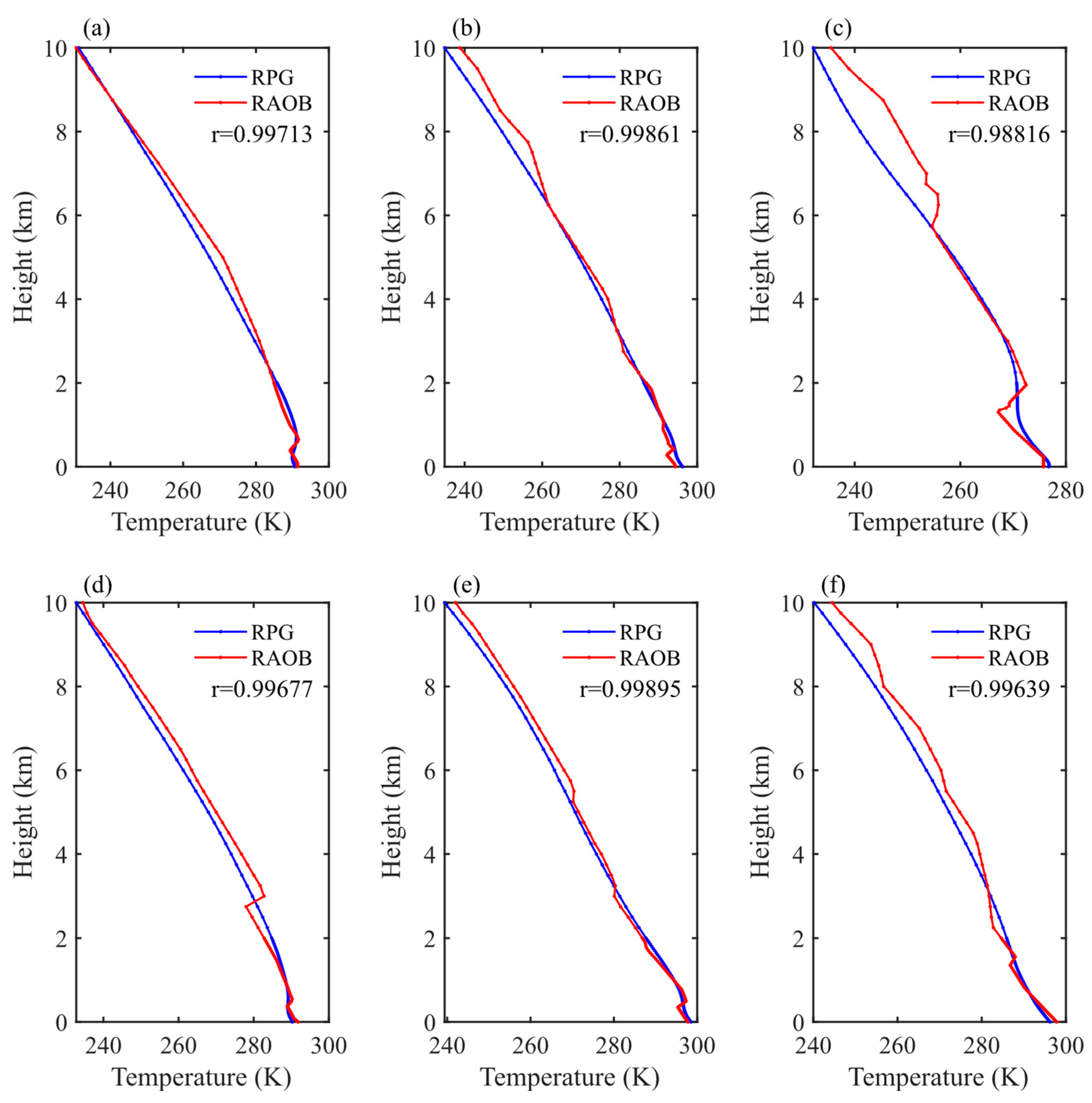
Publisher’s Note: MDPI stays neutral with regard to jurisdictional claims in published maps and institutional affiliations. |
© 2022 by the authors. Licensee MDPI, Basel, Switzerland. This article is an open access article distributed under the terms and conditions of the Creative Commons Attribution (CC BY) license (https://creativecommons.org/licenses/by/4.0/).
Share and Cite
Liu, M.; Liu, Y.-A.; Shu, J. Characteristics Analysis of the Multi-Channel Ground-Based Microwave Radiometer Observations during Various Weather Conditions. Atmosphere 2022, 13, 1556. https://doi.org/10.3390/atmos13101556
Liu M, Liu Y-A, Shu J. Characteristics Analysis of the Multi-Channel Ground-Based Microwave Radiometer Observations during Various Weather Conditions. Atmosphere. 2022; 13(10):1556. https://doi.org/10.3390/atmos13101556
Chicago/Turabian StyleLiu, Meng, Yan-An Liu, and Jiong Shu. 2022. "Characteristics Analysis of the Multi-Channel Ground-Based Microwave Radiometer Observations during Various Weather Conditions" Atmosphere 13, no. 10: 1556. https://doi.org/10.3390/atmos13101556
APA StyleLiu, M., Liu, Y.-A., & Shu, J. (2022). Characteristics Analysis of the Multi-Channel Ground-Based Microwave Radiometer Observations during Various Weather Conditions. Atmosphere, 13(10), 1556. https://doi.org/10.3390/atmos13101556






